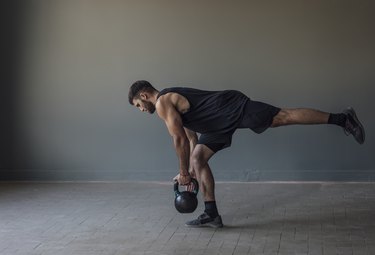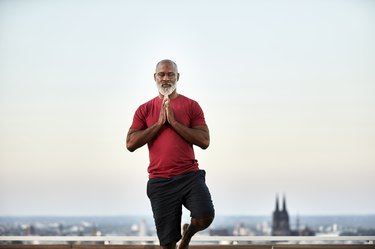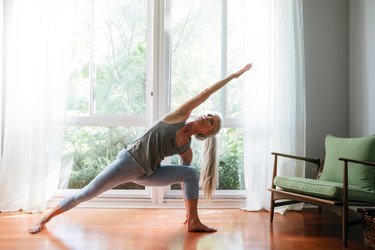

Standing on a single leg sounds like a cinch, but if your balance is lacking, it can be quite a challenge.
There are many reasons why a person may have trouble balancing on one leg, says Winnie Yu, DPT, CPT, a physical therapist at Bespoke Treatments in New York City. Some of the most common include:
Video of the Day
- Ankle issues (such as decreased ankle stability, prior ankle sprains/injuries or ankle pain)
- Knee or hip pain
- Problems with your vestibular system (which plays an important role in your sense of balance and spatial orientation)
- Visual impairments
Aging can also affect balance and make you feel shaky on your feet, particularly when doing activities that require single-leg stability. Not to mention, unilateral balance is a skill — something you must develop and practice to maintain.
While we tend to neglect balance training, it's just as important for a healthy body as strength or cardio workouts. Especially as you grow older, good balance can help you stay active, maintain your independence and help prevent falls (which become more common with age).
Want to learn how to improve balance on one leg? These five exercises will help you stay stable and strong when standing on one leg.
Warning
If you have severe balance issues or a medical condition that can impair your ability to balance, first speak with your doctor before performing balance exercises.
5 Best Exercises to Help You Build Single-Leg Balance
To see the best results in your balance, aim to perform the following exercises every day. Because you only use your own body weight (or light resistance), doing them daily is completely safe.
So, how can you incorporate the moves into your regular routine?
"If you already have a good workout regimen, consider adding these exercises as part of your warm-up to improve muscle activation and blood flow to the musculature around your ankles, knees and hips," Yu says.
You can also sneak these moves into your workday to break up prolonged bouts of sitting at the computer, Yu says. This not only benefits balance but also brings more blood flow to your legs and helps you steer clear of stiff hips.
Likewise, you can also "opt to do these as a morning routine if you want to start the day feeling accomplished with a nice short circuit," she adds.
Try whatever works for you and stick to it: You're guaranteed to see gains in your balance in no time.
1. Banded Ankle Eversion
Your ability to balance on a single leg will be limited if you have weak ankles.
"This exercise helps to improve your ankle strength and stability," Yu says. "The muscles worked in this move also reduce your risk of inversion ankle sprains."
Also called a lateral ankle sprain, an inversion injury is the most common kind of ankle sprain, according to Harvard Health Publishing. This occurs when your ankle rotates inwards.
An inversion sprain can damage the ligaments (i.e., bands of fibrous tissue that connect bones) of the outer ankle including the anterior talofibular ligament, the calcaneofibular ligament and the posterior talofibular ligament, per Harvard Health Publishing.
By strengthening the outer muscles of your ankle through banded eversions, you can help combat the risk of your ankle rolling inward and causing injury.
- Start by sitting in a chair with a mini band around the arches of your feet.
- Keep your feet hip-width apart to place tension on the band.
- With one foot firmly placed on the floor as your anchor foot, rotate the forefoot of your other foot outward (away from your anchor foot) against the resistance of the band.
- Do 10 reps, then repeat on the opposite side.
Tip
“Make sure the motion is coming from the ankle and not the entire leg,” Yu says.
2. Banded Ankle Inversion
Similar to the banded ankle eversion, this exercise builds strong, stable ankles. However, the banded inversion movement (which involves turning your foot so that your sole faces inward) targets your inner ankle muscles.
Incorporating both moves into your daily program is essential for healthy ankles and, consequently, better balance.
"With the combination of the banded inversion and banded eversion exercises, you can improve the strength of the muscles that support the inner and outer aspects of the lower limb," Yu says.
- Start by sitting in a chair with a mini band around the arches of your feet.
- Cross one leg over the other, maintaining tension on the band between your feet.
- Rotate the forefoot of your top foot away from your anchor foot (i.e., the one planted on the floor) against the resistance of the band.
- Do 10 reps, then repeat on the opposite side.
3. Tibialis Posterior Raise With Ball
This heel-raise exercise enhances the strength of the tibialis posterior muscle.
"This muscle helps to plantarflex [point the foot], invert the foot [turning the ankle in] and also to create stability at the arches of the foot," Yu says.
By building lower limb strength and stability, you set yourself up for better unilateral balance.
"Performing this exercise with a ball further ensures proper weight distribution between the big toe and pinky toe and prevents compensatory rolling of the ankle," Yu adds.
- Start by standing with a tennis or lacrosse ball placed between your hind feet.
- Gently squeeze the ball between your hind feet, and while maintaining contact of your big toe and pinky toe to the ground, lift your heels off the floor.
- Do 10 to 15 reps.
4. Single-Leg Dumbbell Pass
By adding a dynamic upper-body component of weighted passes, this single-leg exercise really challenges your balance and stability, Yu says.
Here's why: As you pass the dumbbell from side to side, your center of mass moves in different directions, she says. That means your core and lower body must work overtime to stay stable and keep you from wobbling or falling.
At first, you might feel a little unsteady on your feet when doing this movement. That's OK. Just take it slowly. Over time, with consistent practice, your lower-limb balance and stability will improve.
- Start by holding one dumbbell at your side and standing with your feet hip-width apart.
- Shift your weight to your right and lift your left foot from the ground.
- Brace your core and your right leg’s glute muscle.
- With a gentle bend in your right knee, hinge your torso forward from your hips and lift your left leg slightly behind you.
- Maintain contact of your pinky toe, big toe and heel of your right foot to the ground to form a “tripod stance.”
- Slowly and with control, pass the dumbbell from side to side.
- Do 10 reps, then switch sides.
5. Single-Leg Deadlift
The ultimate bang for your exercise buck, single-leg deadlifts are a higher-level exercise that accomplishes many things all at once: They simultaneously strengthen your ankles, knees, hips and core musculature, Yu says.
And they're extremely beneficial for building better unilateral balance. As your torso and leg move in opposite directions during the exercise, you challenge your core and lower body, including your limbs and pelvis, to stay sturdy and stable, Yu says.
Once you master the body-weight movement, single-leg deadlifts can eventually be progressed by adding weight to further the strength and balance challenges, she adds.
- Start by standing with your feet at hip-width apart.
- Shift your weight to your right leg and lift your left foot from the ground.
- With a gentle bend in your right knee, hinge your torso forward from your hips while your left leg simultaneously lifts back in a reciprocal motion. Lean forward until your trunk and back leg are parallel to the floor.
- To help provide stability at your pelvis and torso, brace your core and engage your standing leg’s glute muscles (think: squeeze your butt cheek) as you move through the exercise.
- Lower your leg and return to the starting position.
- Do 10 reps, then repeat on the opposite side.
Tip
“Keep your torso straight throughout the movement without rounding from your upper or lower back,” Yu says.
Was this article helpful?
150 Characters Max
0/150
Thank you for sharing!
Thank you for your feedback!


